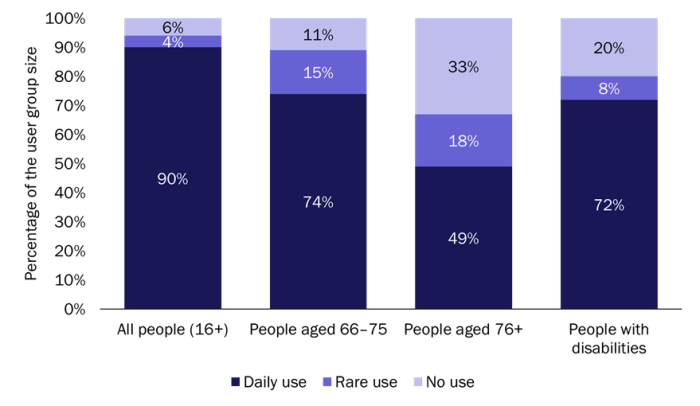Digital inclusion and the European Accessibility Act: both a necessity and an opportunity for TMT players
The transition to a more-digital world provides many new opportunities that can affect our everyday lives. However, the digital world is not accessible to all. Indeed, 8% of 16–74 year olds in the EU did not use the internet at all in 2021.1 The digital divide is even greater on a global level: more than a third of the world’s population (that is, 2.9 billion people) did not use the internet in 2021.2
The European Accessibility Act aims to improve digital inclusion
People with disabilities and the elderly are the most likely to be excluded from the digital world. Here, we take Sweden as an example, even though the country had one of the highest levels of internet usage in the EU in 2021.1 Internet usage among various user groups in Sweden differs significantly. Only 6% of Swedish people aged 16 and above did not use the internet in 2021.3 This figure grew to 20% among people with disabilities (of all ages) and to 33% among people aged 76 and above (Figure 1).
Figure 1: Internet usage among various user groups, Sweden, 20213

Source: Internetstiftelsen, 2021
The European Accessibility Act (EAA) addresses the digital divide by aiming to improve the internal market in the EU for accessible products and services.4 Improved accessibility will increase digital inclusion by helping people with disabilities to participate in our ever more digitalised society. The EAA is therefore a step forward in reducing the barriers for people with disabilities in the EU. The act will come into force in 2025 and will cover a range of products and services in the TMT sector, including computers and operating systems, smartphones, telephony services, TV equipment related to digital television services and e-commerce. The affected products and services must be designed and produced to fulfil a range of requirements with regards to accessibility, including the use of text-to-speech technology, the availability of instructions via more than one sensory channel and the provision of software and hardware for interfacing with the assistive technologies.
TMT players must start preparing now in order to be able to comply with the new act.
TMT players currently have a relatively limited understanding of the consequences of the European Accessibility Act
TMT players will face several challenges when integrating digital accessibility and inclusion into their businesses. The level of readiness varies, but in many cases, it needs to improve. Analysys Mason performed a study in 2021 on behalf of the Swedish Post and Telecom Authority covering the biggest telecoms operators in Sweden. The results show that operators’ knowledge of the specific requirements of the EAA is still relatively limited. The results further highlight the importance of co-ordination and collaboration between different departments because complying with the EAA will involve legal/compliance expertise as well as technical and commercial knowledge. The costs and benefits of adhering to the EAA from a business perspective have proved to be difficult to estimate, thereby further complicating the planning and preparation process. However, our interview-based study that examined the consequences of EAA in Sweden concluded that there will be material costs.
Nonetheless, complying with the act is also expected to benefit TMT players. Improving the accessibility of products and services may bring additional revenue because more people will be able to make use of them. Expanding the customer base and improving the customer experience across the board provides TMT actors with further incentives to embrace digital inclusion.
Analysys Mason supports TMT players in improving their digital accessibility
Analysys Mason has performed a number of projects in the area of digital inclusion and accessibility and can provide TMT players with guidance about how to improve the digital accessibility of their products and services in order to adhere to the EAA. We have experience in supporting clients to integrate a user perspective throughout the development process, including methods such as usability testing. We have also developed a framework to perform cost/benefit calculations based upon our study of the costs and benefits of the EAA in Sweden.
1 Eurostat (2021), Digital economy and society statistics – households and individuals. Available at: https://ec.europa.eu/eurostat/statistics-explained/index.php?title=Digital_economy_and_society_statistics_-_households_and_individuals#Internet_usage.
2 International Telecommunication Union (2021), Measuring digital development. Facts and figures. Available at: https://www.itu.int/en/ITU-D/Statistics/Documents/facts/FactsFigures2021.pdf.
3Internetstiftelsen (2021), Svenskarna och internet. Available at: https://svenskarnaochinternet.se/rapporter/svenskarna-och-internet-2021/.
4 European Commission, European Accessibility Act. Available at: https://ec.europa.eu/social/main.jsp?catId=1202#navItem-1. European Commission, European Accessibility Act – Improving the accessibility of products and services in the single market. Available at: https://ec.europa.eu/social/BlobServlet?docId=14869&langId=en.
Article (PDF)
DownloadAuthor

Jenny Robertsson
PartnerRelated items
Framework report
Unlocking new markets with sustainable products and services: opportunities for vendors, operators and cloud providers
Article
Which operator is top of the sustainability leaderboard? Using benchmarking to see who is performing best
Project experience
Enhancing Microsoft’s product and marketing strategy and strengthening its position as a thought leader in the SMB segment

